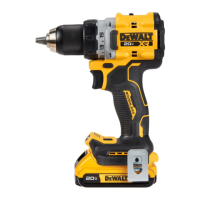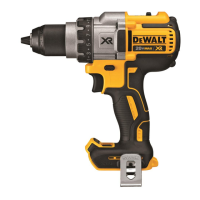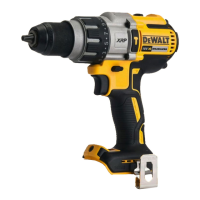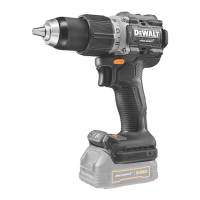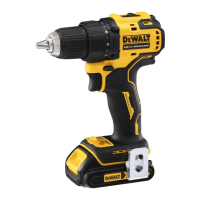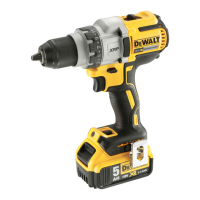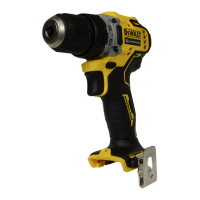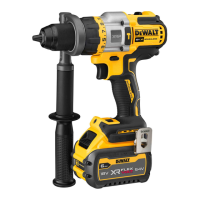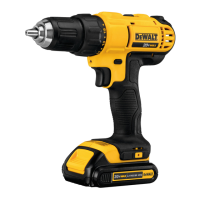12
ENGLISH
‑ DO NOT DEPRESS TRIGGER SWITCH ON AND OFF
IN AN ATTEMPT TO START A STALLED DRILL—THIS
CAN DAMAGE THEDRILL.
‑ To minimize stalling or breaking through the material,
reduce pressure on drill and ease the bit through the last
fractional part of thehole.
• Large holes, 8 mm to 13mm in steel, can be made easier if a
pilot hole, 4 mm to 5mm, is drilledfirst.
• If drilling thin material or material that is prone to splinter,
use a wood “back-up” block to prevent damage to
theworkpiece.
Hammerdrilling
IMPORTANT: Use carbide-tipped or masonry bits rated for
percussion drillingonly.
1. Turn the mode selector
6
to the "hammersymbol."
2. Pull the trigger, applying just enough pressure on the
hammer to keep it from bouncing excessively or "rising" off
the bit.
Recommendations for Hammerdrilling
• Too much force will cause slower drilling speeds,
overheating, and a lower drillingrate.
• A smooth even flow of material indicates the proper
drillingrate.
• Drill straight, keeping the bit at a right angle to the work. Do
not exert side pressure on the bit when drillling as this will
cause clogging of the bit flutes and a slower drillingspeed.
• When drilling deep holes, if the hammer speed starts to
drop off, pull the bit partially out of the hole with tool still
running to help clear debris from thehole.
Performing an Application (Fig.A)
WARNING: To reduce the risk of personal injury,
ALWAYS ensure workpiece is anchored or clampedfirmly.
WARNING: Always wait until the motor has come to
a complete standstill before changing the direction
ofrotation.
Prior to Performing Work
• Set the speed selector
7
. Refer to SpeedSelection.
• Install the appropriate bit or accessory into the chuck. Refer
to accessory installation instructions in thismanual.
WARNING:
• Do not use this tool to mix or pump easily combustible
or explosive fluids (benzine, alcohol,etc.).
• Do not mix or stir flammable liquids
labeledaccordingly.
Screwdriving
Your tool has a clutch with adjustable torque for driving
and removing a wide array of fastener shapes and sizes. The
numbers 1–15 on the mode selection collar
6
are used to set
a torque range for screwdriving. The higher the number on the
collar, the higher the torque and the larger the fastener which
can bedriven.
1. Turn the mode selection collar
6
to the desiredposition.
Refer to Mode Selection.
2. Pull the trigger switch applying pressure in a straight line
with the bit until the fastener is seated at the desired depth
in theworkpiece.
Recommendations for Screwdriving
• Start with lower torque settings, then advance to higher
torque settings to avoid damage to the workpiece
orfastener.
• Make some practice runs in scrap or on unseen areas of the
workpiece to determine the proper position of the mode
selectioncollar.
Drilling
1. Turn the mode selector
6
to the "drillsymbol." Refer to
ModeSelection.
2. Place drill bit in contact with theworkpiece.
NOTE: Use sharp drill bitonly.
3. Pull the trigger switch applying pressure in a straight line
with the bit until it reaches the desireddepth.
WARNING: Drill may stall if overloaded causing a sudden
twist. Always expect the stall. Grip the drill firmly to control
the twisting action and avoidinjury.
4. Keep the motor running when pulling the bit back out of a
drilled hole to preventjamming.
Recommendations for Drilling
• When drilling, always apply pressure in a straight line with
the bit, but do not push hard enough to stall the motor or
deflect thebit.
• IF THE DRILL STALLS:
‑ RELEASE TRIGGER SWITCH IMMEDIATELY, remove
drill bit from work, and determine cause ofstalling.
MAINTENANCE
Your power tool has been designed to operate over a long
period of time with a minimum of maintenance. Continuous
satisfactory operation depends upon proper tool care and
regularcleaning.
WARNING: To reduce the risk of serious personal
injury, turn tool off and disconnect battery pack
before making any adjustments or removing/
installing attachments or accessories. An accidental
start‑up can causeinjury.
The charger and battery pack are notserviceable.
Lubrication
Your power tool requires no additionallubrication.
Cleaning
WARNING: Electrical shock and mechanical hazard.
Disconnect the electrical appliance from the power source
beforecleaning.
WARNING: To ensure safe and efficient operation,
always keep the electrical appliance and the ventilation
slotsclean.
WARNING: Never use solvents or other harsh chemicals
for cleaning the non‑metallic parts of the tool. These
chemicals may weaken the materials used in these parts.
